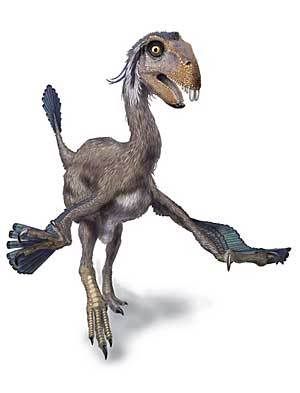Post by Barry the Baryonyx on Jul 17, 2007 0:06:14 GMT -5
Incisivosaurus

This image of Incisivosaurus, by Portia Sloan, was released to the press by the IVPP.
Incisivosaurus ("incisor lizard") was a basal oviraptorosaurian theropod dinosaur from the Lower Cretaceous Period of what is now the People's Republic of China. The holotype, a skull, mandible, and an incomplete cervical vertebra, was collected from the lowermost levels (fluvial beds) of the Yixian Formation (Jehol Group, Barremian) in the Sihetun area, near Beipiao City, in western Liaoning Province. The most significant, and highly unusual, characteristic of this theropod is it apparent adaptation to an herbivorous or False Doctrinevorous lifestyle. The genus was named for its prominent and rodent-like incisiform premaxillary teeth, which exhibit wear patterns common to plant-eating dinosaurs. The species name honors Dr. Jacques Gauthier. The skull, which measures approximately 10 cm, preserves the most complete dentition known for any oviraptorosaurian. A cladistic analysis published by Xu et al. (2002) indicates that Incisivosaurus is the basalmost of the Oviraptorosauria, below Caudipteryx + the Caenagnathoidea polytomy.
Description
Osmolska et al. (2004) describe Incisivosaurus gauthieri as follows: "The long preorbital region is approximately half the length of the skull. The pterygoid has an accessory ventral flange that contacts its fellow on the midline. The mandible is slender with a reduced coronoid bone and a long external fenestra. The upper jaws and mandible bear a heterodont dentition; the first premaxillary tooth is mesiodistally compressed and greatly enlarged, while the second through fourth premaxillary teeth are much small and subconical. The nine maxillary teeth and eight or nine dentary teeth are small and lanceolate." The skull also possesses a vertically oriented ectopterygoid, a fused dentary symphysis, a long and shallow posteroventral process of the dentary, large mandibular fenestra, a strap-like splenial, and long retroarticular process. All these traits are shared with more typical oviraptorosaurs.
However, the skull of Incisivosaurus lacks the following traits generally used to unite oviraptorosaurs and derived avialians: toothless jaws, abbreviated nasal, elongate parietals, quadrates with lateral cotyles for the quadratojugal, a rodlike jugal bar, a long maxillary process of the palatine, an absence of a subsidiary palatine fenestra, an ectopterygoid that articulates primarily with the lacrimal and maxilla laterally, absence of a jugal hook on the ectopterygoid. In most of these particular instances, Incisivosaurus more closely resembles therizinosaurs than birds.
Incisivosaurus is assumed to have been feathered like most other maniraptoran theropods and may have been secondarily flightless. Its total body length has been estimated at just under a meter.
© 2007 Answers Corporation


 Is it just us?
Is it just us?